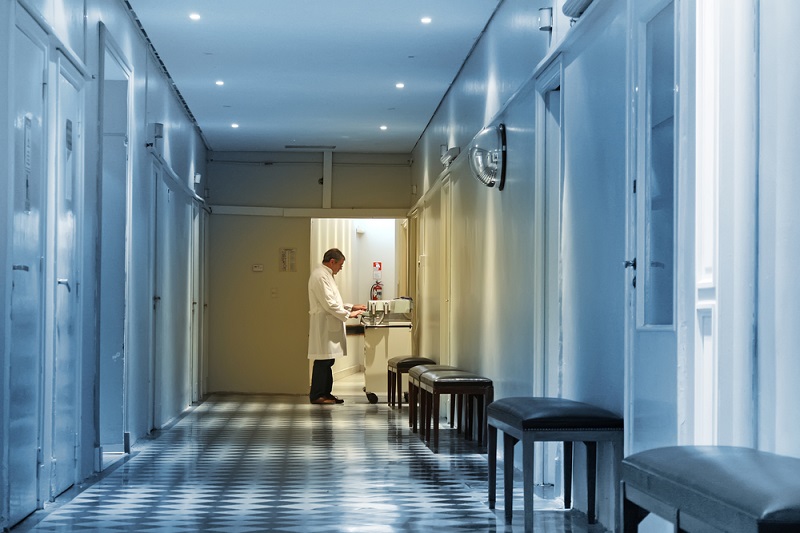Making Adult Hospitals More Like Children Hospitals

A gigantic bounce house, video games at every turn, cartoons on flatscreen TVs, a playground that dwarfs anything down at the local schoolyard … The best children's hospitals certainly come across as fun places to visit.
Wouldn't it be great if adult hospitals were like this, too? Well, seriously, why aren't they? One medical student asks that question in an editorial published today (Aug. 20) in the Journal of the American Medical Association (JAMA).
Say what you will about Dr. Patch Adams and his humor-based approach to medicine, but children's hospitals are designed the way they are for two reasons: Kids don't want to be in a hospital, and higher spirits while in a hospital translate to better health outcomes. [9 Weird Ways Kids Can Get Hurt]
Mark Attiah, a fourth-year medical student at Penn Medicine, part of the University of Pennsylvania in Philadelphia, asks: How are adults any different from children?
Attiah was inspired to write the JAMA editorial after visiting one such pleasant children's hospital during his pediatric medical rounds. The concept later crystallized, he said, when he met a patient who became an adult overnight, by turning from age 17 to 18. That patient was out of the children's ward, with all its comforts, and into the adult ward — a change, the patient said, that was like day to night, or heaven to hell.
Gone were the activities to fill the day, such as art and games and even a hospital prom. Gone were the privileges common to children's hospitals, such as having family members around at any time, even overnight. All this newly minted adult patient could do was lie around, dwelling on her illness, Attiah said.
While it may seem like common sense that all hospitals could stand to be a little more inviting, "sometimes in medicine, common sense is overlooked for decidedly loftier goals, like waiting for peer-reviewed evidence and doing something a certain way because that's how it's always been done," Attiah told LiveScience.
Sign up for the Live Science daily newsletter now
Get the world’s most fascinating discoveries delivered straight to your inbox.
Although Attiah currently has zero years of experience as a medical doctor, his idea resonates with many in the medical establishment. Attiah's own hospital has newly erected buildings with patient-friendly features, such as direct sunlight, pleasant distractions, more social-support, less noise, and single bedrooms, said Patrick Brennan, the chief medical officer of the University of Pennsylvania Health System.
The best hospitals in the nation are following suit. And although this is a positive trend, this isn't specifically what Attiah is after.
"While hospitals might remodel their exterior, they should remember that some of the most important and perhaps the hardest changes to be made aren't with bricks and mortar," Attiah said. "You could be eating at a five-star restaurant and still get terrible service. I think the more substantive changes ... are the care patterns and the attitudes of the healthcare workers themselves."
These changes — in addition to brighter hallways and more art and plants — could include extended visiting hours, more family involvement during patient procedures and discussions, a medical staff that seems truly happy to be there serving, and lots and lots of activities, all of which have been standard practices in children's hospitals for decades.
A large study published in March 2013 in the New England Journal of Medicine found that having family members present during scary procedures such as cardiopulmonary resuscitation (CPR) had a positive effect on health outcomes, did not interfere with medical efforts, did not increase stress in the health care team and did not result in legal conflicts — overturning several long-standing assumptions.
Perhaps adults find comfort in suffering, along the lines of "no pain no gain." Consider no-tears children's shampoo. Adults apparently don't mind their eyes stinging when washing their hair. The heart of Attiah's idea is to strive for no-tears hospitals, for children and adults.
Christopher Wanjek is the author of a new novel, "Hey, Einstein!", a comical nature-versus-nurture tale about raising clones of Albert Einstein in less-than-ideal settings. His column, Bad Medicine, appears regularly on LiveScience.

Christopher Wanjek is a Live Science contributor and a health and science writer. He is the author of three science books: Spacefarers (2020), Food at Work (2005) and Bad Medicine (2003). His "Food at Work" book and project, concerning workers' health, safety and productivity, was commissioned by the U.N.'s International Labor Organization. For Live Science, Christopher covers public health, nutrition and biology, and he has written extensively for The Washington Post and Sky & Telescope among others, as well as for the NASA Goddard Space Flight Center, where he was a senior writer. Christopher holds a Master of Health degree from Harvard School of Public Health and a degree in journalism from Temple University.
What are mRNA vaccines, and how do they work?
Deadly motor-neuron disease treated in the womb in world 1st









